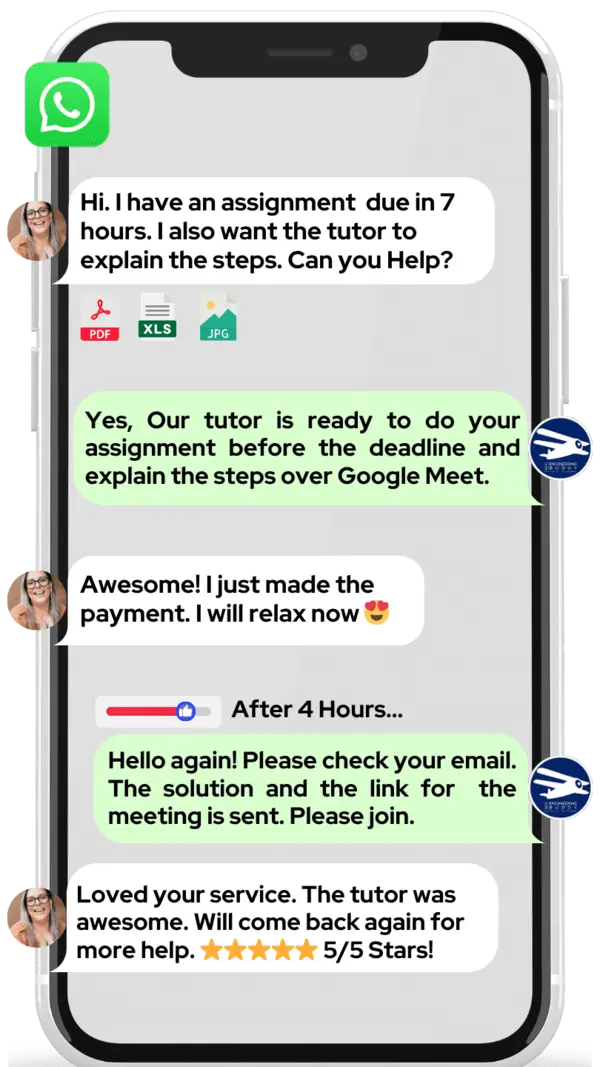

Hire The Best Aeroacoustics Tutor
Top Tutors, Top Grades. Without The Stress!
10,000+ Happy Students From Various Universities
Choose MEB. Choose Peace Of Mind!
How Much For Private 1:1 Tutoring & Hw Help?
Private 1:1 Tutors Cost $20 – 35 per hour* on average. HW Help cost depends mostly on the effort**.
Aeroacoustics Online Tutoring & Homework Help
What is Aeroacoustics?
Aeroacoustics is the interdisciplinary study of noise generated by airflow interacting with surfaces and structures in aerospace applications. It combine fluid mechanics, acoustics, and computational fluid dynamics (CFD) to predict, analyze, and control noise sources. Real life examples include jet engine roar, helicopter blade screech, and wind turbine whine.
Also known as aero‑noise, aerodynamic noise, flow noise, airframe noise, or jet noise.
Key topics include noise generation mechanisms like vortex shedding, turbulent boundary layer interaction, and rotor‑stator effects. Wave propagation and scattering in compressible flows play a major role. Source modeling techniques range from Lighthill’s acoustic analogy to Ffowcs Williams–Hawkings equations. Computational approaches involve high‑fidelity CFD simulations and boundary element methods. Experimental methods like microphone arrays, beamforming, and anechoic wind tunnels are crucial. Noise reduction strategies cover passive measures (e.g., serrated edges on wings) and active control (e.g., adaptive liners in turbofan engines). Real world projects involve reducing sonic booms for supersonic jets or designing quiet HVAC systems in spacecraft.
Interest in aeroacoustics began with Sir James Lighthill’s groundbreaking acoustic analogy in 1952, which framed aerodynamic noise in terms of quadrupole sound sources. During the 1960s, Cherry and Goldstein refined Lighthill’s theory for jet noise. In the 1970s and ’80s NASA launched extensive wind tunnel experiments to map airframe noise from landing gear and flap edges. Computational advances in the 1990s enabled high‑resolution CFD studies, while the 2000s saw application of beamforming arrays to visualize noise sources in real time. Recently, focus has shifted to reducing sonic booms for commercial supersonic flight and integrating quiet electric propulsion technologies.
How can MEB help you with Aeroacoustics?
Do you want to learn aeroacoustics? MEB offers one‑on‑one online aeroacoustics tutoring with a personal tutor.
If you are a student and want top grades on assignments, lab reports, tests, projects, essays or dissertations, you can use our 24/7 instant online aeroacoustics homework help service. You can message us on WhatsApp. If you do not use WhatsApp, send an email to meb@myengineeringbuddy.com
Our students come from many countries, including the USA, Canada, the UK, the Gulf, Europe and Australia.
Students ask for help for many reasons. Some subjects are hard. Some have too many assignments. Some questions and ideas take a long time to understand. Some face health or personal issues. Others work part‑time or miss classes and fall behind.
If you are a parent and your student is finding this subject difficult, get in touch with us today. Our tutor will help your ward do well on exams and homework. Your ward will thank you.
MEB also offers help in more than 1,000 other subjects. Our tutors and experts make learning easier and help students succeed. It is important to ask for help when you need it so you can have a stress‑free school life.
DISCLAIMER: OUR SERVICES AIM TO PROVIDE PERSONALIZED ACADEMIC GUIDANCE, HELPING STUDENTS UNDERSTAND CONCEPTS AND IMPROVE SKILLS. MATERIALS PROVIDED ARE FOR REFERENCE AND LEARNING PURPOSES ONLY. MISUSING THEM FOR ACADEMIC DISHONESTY OR VIOLATIONS OF INTEGRITY POLICIES IS STRONGLY DISCOURAGED. READ OUR HONOR CODE AND ACADEMIC INTEGRITY POLICY TO CURB DISHONEST BEHAVIOUR.
What is so special about Aeroacoustics?
Aeroacoustics explores how air movement in and around machines makes sound. It is unique because it merges fluid flow and noise science into one field. This blend helps engineers study sounds from fans, engines, or wings in detail. The subject focuses on measuring, predicting, and reducing noise, making it special for designing quieter aircraft and better wind turbines with real-world impact.
In comparison to other aerospace topics, Aeroacoustics offers hands‑on experiments and computer simulations for noise control, boosting creativity and career options in green aviation. However, the math and physics can be tough, and setting up experiments is often expensive. Fewer university courses exist, so resources may be limited. The subject demands attention to detail but rewards you with skills in cutting‑edge noise reduction techniques.
What are the career opportunities in Aeroacoustics?
Students who finish an Aeroacoustics course can go on to earn a master’s or Ph.D. in aerospace, mechanical engineering, or applied physics. Many universities now offer special tracks in noise control and vibration. Recent trends focus on quieter drone designs, electric aircraft, and sustainable aviation, making advanced studies a big advantage.
Typical job titles include aeroacoustic engineer, noise and vibration analyst, CFD specialist, and R&D engineer. In these roles you might measure sound levels in wind tunnels, run computer simulations of airflow, design engine liners or propeller tips, and help aircraft makers meet strict noise rules. Work is a mix of lab testing, software modeling, and field trials.
We learn and prepare for tests in Aeroacoustics to build strong skills in physics, math, and computer tools. This study helps you understand how air moving over wings, propellers, or turbine blades creates sound. Solid test prep also teaches how to use software like MATLAB or ANSYS for real problems.
Aeroacoustics knowledge is used to make quieter jets, drones, and wind turbines, improving passenger comfort and cutting noise pollution. Companies and regulators set ever-stricter limits, so experts in sound reduction are in demand. This work also supports greener aviation by reducing community impact.
How to learn Aeroacoustics?
Start by building a strong base in fluid dynamics and basic acoustics. Follow these steps: review key equations, watch short lectures, solve simple problems, then move to more complex cases. Use simulation tools (like MATLAB or ANSYS) to visualize sound waves and noise sources. Read one research paper weekly to see how experts apply theory. Practice clear, step‑by‑step notes and revise regularly to reinforce your understanding.
Aeroacoustics can seem tough because it mixes fluid flow and sound theory. Breaking it into smaller topics—like turbulence noise, sound propagation, and acoustic analogy—makes it manageable. Steady practice and focusing on one concept at a time will lower the difficulty. Most students find persistence and practical examples help make it feel easier over time.
You can self‑study aeroacoustics if you’re disciplined, use good textbooks, online courses, and practice problems. A tutor becomes valuable when you hit tricky concepts or need structured feedback. Personalized guidance can speed up learning, help you avoid common mistakes, and clarify doubts immediately—especially if your background in fluids or acoustics is limited.
Our tutors at MEB offer tailored support through 24/7 online 1:1 tutoring and assignment help. We design study plans that match your pace and focus on areas you find hardest. Whether you need quick homework assistance or in‑depth exam prep, our experienced aerospace engineers guide you step by step. We keep fees affordable so quality help fits any student budget.
Most students need about 3–6 months of regular study (around 5–8 hours per week) to grasp core aeroacoustics concepts and techniques. If you already know fluid mechanics and basic acoustics, you might finish in 3 months. Beginners usually take closer to 6 months. Consistent weekly practice and periodic reviews are key to steady progress and good exam scores.
Here are some top resources you can trust: YouTube channels: MIT OpenCourseWare “Fundamentals of Aeroacoustics,” Stanford’s “Acoustics” playlists. Websites: acoustics.org for basics, NASA’s aeroacoustics tutorials, Coursera and edX courses. Books: “Aeroacoustics” by M. P. Norton, “Theory of Aeroacoustics” by Crighton & Dowling, Lighthill’s “Waves in Fluids,” Goldstein’s “Aeroacoustics.”
College students, parents, tutors from USA, Canada, UK, Gulf and elsewhere—if you need a helping hand, be it online 1:1 24/7 tutoring or assignment support, our tutors at MEB can help at an affordable fee.








